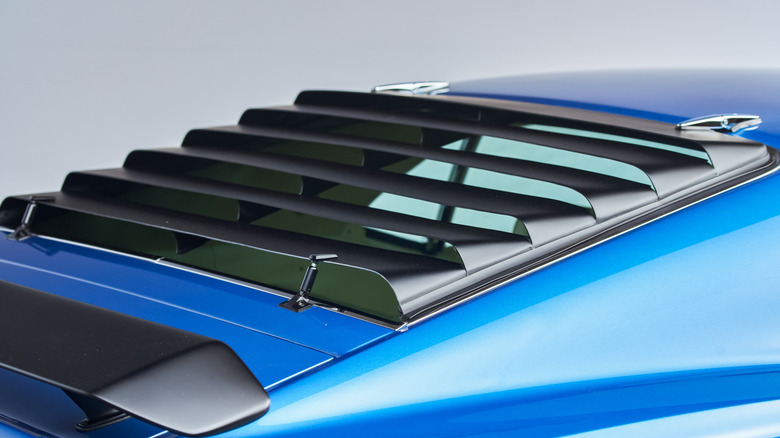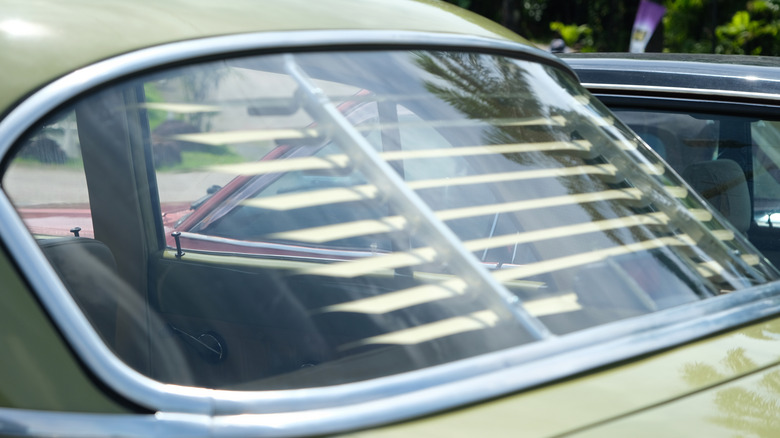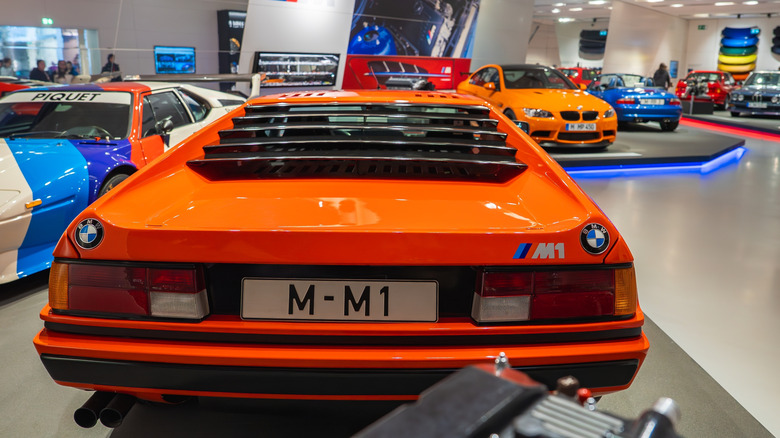Why Did Old Muscle Cars Have Window Louvers? Here's What They Were For
One of the many fads in automotive design that has faded in the 21st century is the window louver. Window louvers are those horizontal slats you see a lot in some cars from the 1980s and prior, along with more recent muscle cars like certain Mustangs and Camaros. They're generally either black plastic or color-matched, and carry a distinct "product of their time" image. Granted, while they were unquestionably a fad, lots of enthusiasts still consider them aesthetically cool — certainly not one of the worst trends we've seen despite their quirks. And a surprising number of cars from the late-1960s to today featured either factory louvers or have extensive aftermarket support for them. You can even make your own with enough time and skill.
Window louvers come in several styles and configurations; they can be thin or thick, cover the side or rear windows, and even sit inside or outside the car. But they all serve functionally two purposes: the first is, fairly obviously, an aesthetic choice. The second is the reason you mainly see these on certain sports cars: it keeps the interior cool by blocking direct sunlight from shining in through the rear window, which also helps with glare. As stated in some advertisements of the time, manufacturers included louvers to prevent heat buildup and protect the interior while adding visual flair. They're particularly useful on cars with prominent rear windows at shallow angles like fastbacks and 2+2s. Let's discuss their function and why they fell out of fashion.
A niche purpose
Let's forego the aesthetics for now and focus on the original function behind the automotive window louver. There's no solid, definitive "first" vehicle to use window louvers — various sources name the Lamborghini Miura as the first vehicle to use rear louvers, though the Shelby GT 350 utilized side louvers in 1965. Other vehicles used similar systems decades earlier, like the Volkswagen Westfalia Bus, which had actual curtains rather than louvers — although they served a similar function.
Essentially, the main goal of a window louver is unpowered climate control. It keeps the sun from shining through the massive rear window, which can act like a greenhouse on some of these older cars with lots of glass. As such, their heyday was the late 1960s through to the 1980s, when boxy fastbacks dominated the sports car market.
Climate control was still developing back then, with only around half of the cars on the road featuring air conditioning in 1969. Window tinting started taking off around this time as well, with 3M developing the first practical window tint in the late 1960s. But these early formats were dye-based and prone to developing bubbles after prolonged heat exposure. So, window louvers provided some of the same benefits as window tinting without the hassle of bubbling — though oxidation is an entirely different can of worms. As technology developed and people's tastes in automotive aesthetics shifted, it's likely that louvers just weren't desirable anymore from a cosmetic or functional perspective, which is why they're seldom seen today.
Which cars feature louvers?
The most common vehicles with factory-fitted or aftermarket louvers are vintage and modern American muscle cars, Japanese sports cars like Nissan Zs, and European saloons and exotics. You'll occasionally see similar devices mounted inside the car as well, generally on classic European cars like Volkswagens and Mercedes-Benzes, though these are more correctly categorized as "window blinds" rather than "louvers."
As far as factory options go, possibly the most famous classic muscle car to feature rear window louvers was the Ford Mustang. This style peaked in 1969, when Mustangs like the Boss and Mach 1 received rear window louvers as a factory-installed option called "Sports Slats," quickly copied by 1970s Mopar E-bodies like the Challenger and Barracuda. It continued through the 1980s with factory-installed louvers featured on cars like the BMW M1, DeLorean (and the DeLorean EV reboot), and Fox Body Mustang. There we also many aftermarket louvers, with kits readily available for everything from your basic Fords, Datsuns, and GMs to unusual choices like the Fiat 124 and Ford Capri.
No cars are manufactured today with factory-installed louvers outside of the occasional limited-production oddball like the rebooted Lamborghini Countach. However, that doesn't mean that their stylistic popularity has waned to the point where they've totally disappeared — if you have something like a modern Camaro, Corvette, Challenger, or Mustang, a rear window louver's a quick Google search and some 3M red tape away.


